|
|
|
Cambodia was one of our
most exciting trips.
The visit to the magical temples
of Angkor in the forest near the straits between
claws of enormous secular trees and leaves you
breathless. |
|
It was impossible to separate
the spectacular view of the monumental Temples
by the thought of what had happened there until
a few years earlier.
What Cambodia had been
under the domination of Kmer Rossi and the
dictatorship of Pol Pot.
|
Everywhere the traces of the recent past
appear, and before all the faces of the people.
|
 |
Angkor is located in the province of Siem Reap,
which lies north of Lake Tonle Sap. It is possible to
arrive by plane or boat.
Schedules change often, but there is almost always a daily
flight between Phnom Penh and Siem Reap.
|
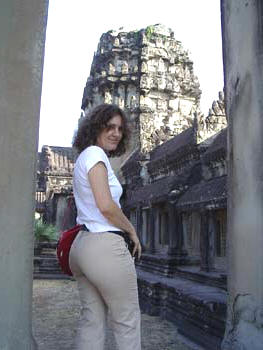 |
In particular, sophisticated and intellectual beauty of
Angkor, there is something profoundly simple, and
natural archetype that comes directly to the heart without
having to go through your head.
In every stone there is an intrinsic magnitude of which
one ends up carrying the small and particular majesty. |
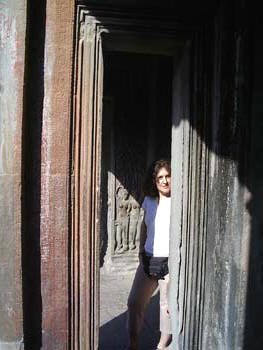 |
You do not need to know that every detail had for its
creators a meaning, that every stone and every sculpture,
every yard and every spire were onto dowels and majestic
mosaic which was to depict the various worlds, including the
one above, with at its center that of the mythical Mount
Meru.
In fact there is no need to be Hindu or Buddhist to
understand.
Just watch and let go to feel the strong impression that
at Angkor, in some way, there has already been. |
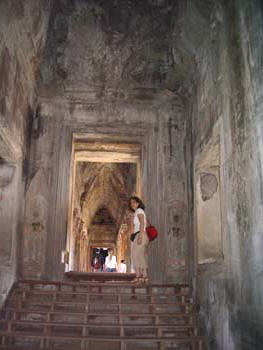 |
In fact until the last century knew very little of
Cambodia. The Mekong has already been
sufficiently explored, but no West had led up to it.
The whole history of the region, moreover, was enveloped
in the dense mystery since time immemorial.
Marginalized from India, China and Japan, but protected
by the jungle, its mountains and its rivers, the land of
kmer had been able to bring up their kingdoms without
incurring foreign oppression. |
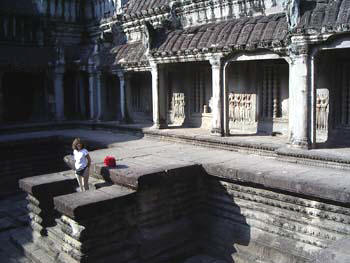 |
From the 8th to 12th Century AD, Angkor was home
of the Kmher, the current population of Cambodia today.
Its borders, referring to the most recent geographic
areas from southern Vietnam to Yunan in China to the west
and ending at the Bay of Bengal. |
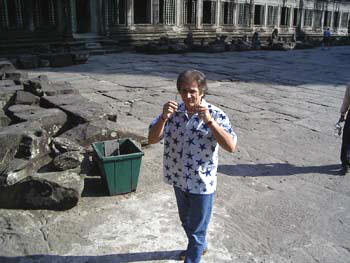 |
When, in 1862, the French naturalist Henri Mouhot,
after losing the path happened among the ruins of an immense
and wonderful city abandoned, took her to be done to
understand what it was as though asking for information to
the farmers themselves of that 'area, they had forgotten his
origins. |
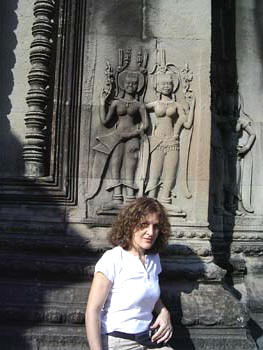 |
It was one of the most extensive archaeological complex
in the world, Angkor was the ancient and noble
capital of kmer. The first study of its ruins was
conducted by another French who took advantage, however, to
remove a few hundred statues, beginning as an unfortunate
habit.
The fame of Angkor, however, remained limited within
archaeological circles, and later, when the trip might have
been less adventurous, the World War broke out. |
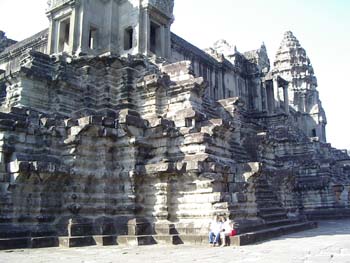 |
In fact, tourism at Angkor is considered a recent event,
dating from 1990.
We can remember that the success enjoyed by these
beautiful and majestic ruin is unparalleled in the world,
statistics indicate that each year the number of visitors
increased by over 2100%. (Unfortunately, the thieves are
also art and in 1994 only 6000 artifacts are missing). |
 |
Like all big cities abandoned and covered by jungle,
half of the suggestion is therefore due to its location.
A morbid fascination to see how it comes from the most
spectacular products of human civilization, once left to
decay can harmonize with nature that gradually integrates
them into itself.
For whole Angkor Temples and Reggie are gutted by huge
trees that you have literally grown up in, sustaining
itself. |
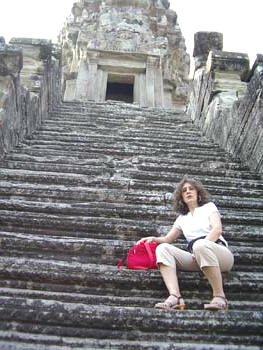 |
Looking for historical references, we find that in 1432
a series of invasions from Thailand forced to abandon the
Khmer Angkor.
So no one lived anymore in those places where, for 4
centuries, the Khmer had built hundreds of temples and
majestic palaces.
And the forest covered, making them his own. |
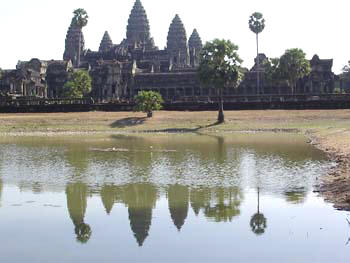 |
For the Cambodians, which was passed after a
century since the end of Angkor, the past 2-3 generations
left no memory of those historical facts that occurred, and
these temples so large and surrounded by impenetrable
jungle, the legend went.
|
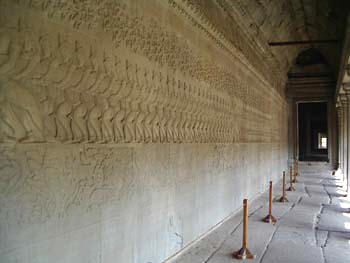 |
Very soon so were not considered work of man but of the
Gods.
Pisnouka, born of a heavenly dancer and a human
being, had been sent to the gods to learn their arts divine.
Seen such temples built by gods and their own and then had a
mandate to return between humans and build similar.
Thus arose Angkor. |
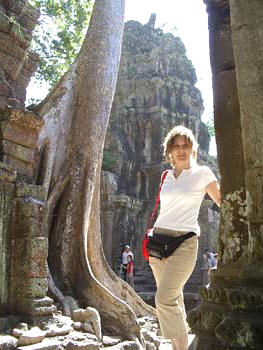 |
Among the temples of Angkor is a distinction to the
majestic beauty and for the 'grandeur, was the temple of
Baphuon.
A Chinese diplomat, Tcheou Tha-Kouan, who visited
Angkor during the last years of the 14th century, was able
to witness all its wonder at the sight of Bapuon and
its fantastic shining copper dome.
|
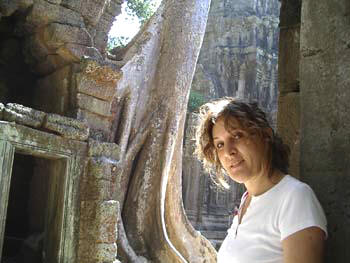 |
Here we could look over the history of the ancient
temples of Angkor, and get to recount the events of our
times. |
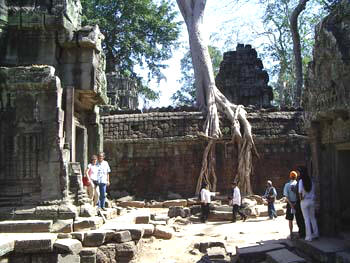 |
At the beginning of this century, to be exact in 1911,
when Jean Commaile known French archaeologist, came
to Angkor to release specified by the forest and the
majestic ancient ruins.
We succeeded and finally riemersero temples and also in a
state not particularly compromise. |
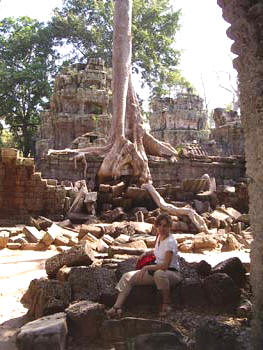 |
The bad luck, however, it breaks down again in these
places; arrived unusually intense rains that caused
landslides and severe damage to deep throughout the area.
Came the Second World War, but especially Commaile died.
Yet fate is repeated, as the temples are again left to
themselves.
|
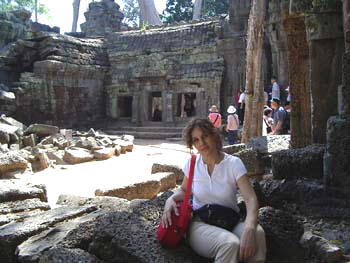 |
You arrive until 1955, when Bernard Philipp Grosliher,
the new curator of the archaeological zone, decided to
return to work on the remains of Baphuon.
One year before other landslides have further complicated
the situation so that the reconstruction of the remains was
not possible, working on what the area presented in its
immediacy. |
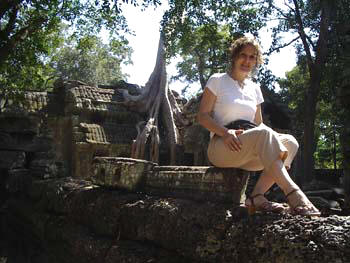 |
Grosliher decided to operate in a completely
different way, number all the pieces, classified them and
began the construction of a puzzle from 303 thousand weaves. |
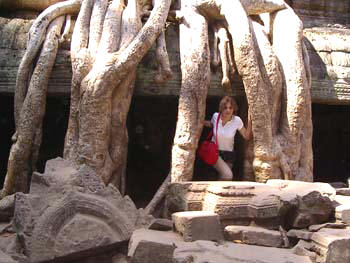 |
It was the story that is returned.
Began the long and devastating conflict in Vietnam, and
Cambodia joined in the terrible vortex that we all know.
The entire archive of Grosliher disappeared, and
the map with
the basic instructions to manage the puzzle went lost. |
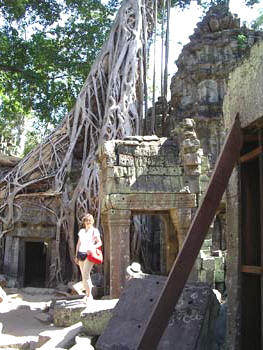 |
The workers who worked in shipyards became part of the
victims of the conflict.
It lost in short, every memory.
Grosliher died in 1985 without having been able to take
in hand the progress report. |
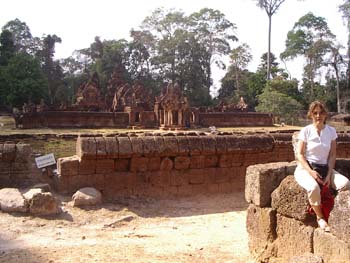 |
In 1994 Jaques Dumarcay new French archaeologist,
reopened the Baphuon yard and discovered that the
basement of the Temple, namely a first part of the work of
Grosliher, was in good condition.
The photograph that appears on this page is 2005. |
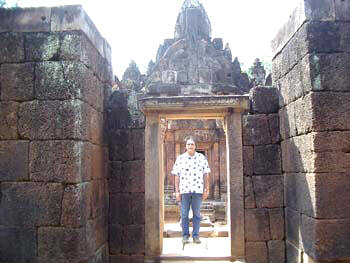 |
It is representative of current conditions of Baphuon,
but at the time, during the past decade, the structure has
suffered further damage.
But it is already possible to discern from the base found
Dumarcay. |
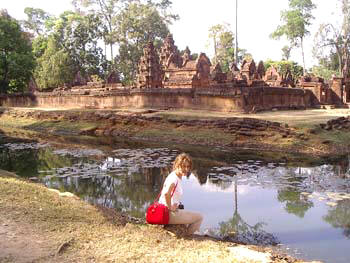 |
Today the restoration are in full swing and it is to
reconstruct a jigsaw puzzle of hundreds of thousands of
pieces.
The technique put in place refers to the most advanced
computer. |
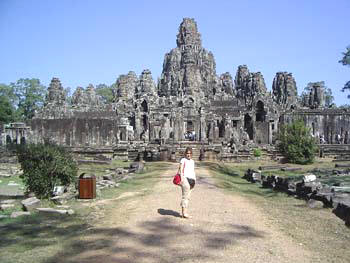 |
Each piece has been stored in its surfaces imagine a
cube with its six sides, to seek, with the use of computers,
the other faces that have the structures to fit.
It is expected that the works have to end in 2006 and now
the level of restoration is high. At this date, the temple
of Baphuon, which is the largest among those of
Angkor - 98 meters from the side to a height of about 49
meters, will return to its primordial forms. |
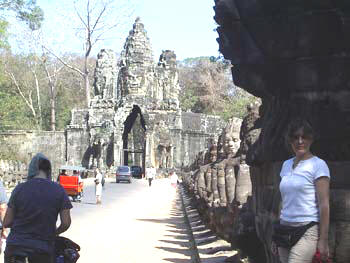 |
Meanwhile, the Cambodian population of those
lands are permanently leaving the legend of the Temple.
Even the people in the countryside, during the years of
war Pisnouka tells of the divine creator of the
Temples, have now realized that they were their fathers to
build the magic of Angkor. |
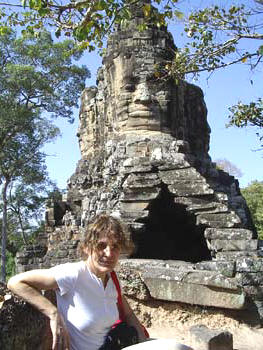 |
The damage that was caused by the Western mentality
(first with colonialism, then by communism and now with
capitalism) to the ancient traditions and culture of
Cambodia is virtually incalculable.
The texts of the last century, describing the land of
kmer as a fantastic natural paradise, a gentle and
peaceful people, and colorful and fragrant countryside,
dotted by rice paddies and agile pagodas, lakes and forests
and fairytale.
|
 |
Siem Reap is on the banks of a large lake where
poor people live hours of expedients in modest shacks.
Visiting the lake like other travelers, notammo a little
girl of 6-7 years who went to greet tourists in a bowl. |
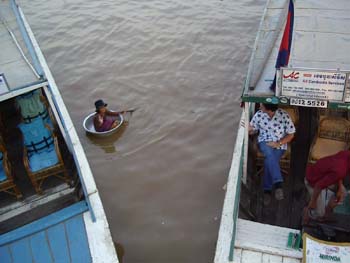 |
She was friendly, well dressed, kind, greeted by the
hand and smiled crafty and it was impossible not to offer a
few dollars.
She this, though so small, has understood very well.
We were sure that would come a long way the girl. ;)
|
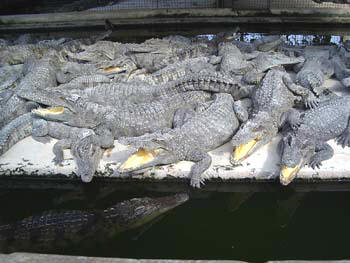 |
The herds of crocodiles are among the resources of the
inhabitants of the region of Angkor on the shores of Lake
Tonle Sap. |
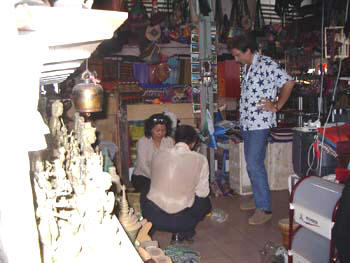 |
The shop of local handicrafts items pack their products
will display in the restaurant Frittomisto. |
|
Between 1974 and 1978 occurred in Cambodia is
one of the most ferocious tragedies in the history of humanity.
The kmer were stained red of systematic physical elimination of
over one million people (about seven million Cambodians who
were) in addition to a high number of invalid because the
torture and landmines.
The concentration camp Coehung Ek, 16 km. from Phnom Penh, is
destined to become a monument to peace.
In the center of the square have been accumulated the skulls
found nell'enorme grave; are some tens of thousands, forming a
pyramid 10 meters high.
Only Auschwitz happened something like that.
And 'This is a shame for the West pretended they did not know,
some political parties and even helped with financing the
dictatorship.
In 1979, the Viet Nam finally did what no one had hitherto had
the courage to do, militarily occupied Cambodia and deposed Pol
Pot
After 1991 the United Nations mediarono a temporary peace
between Pol Pot and his opponents, but soon the fierce red
butcher broke those agreements and settled in the north, where
it remained hidden until his death in circumstances not yet
fully clear, and after which finally ended the nightmare.
 |
 |
Cambodia
Kingdom
Reacheanachak Kampuchéa |
|
 |
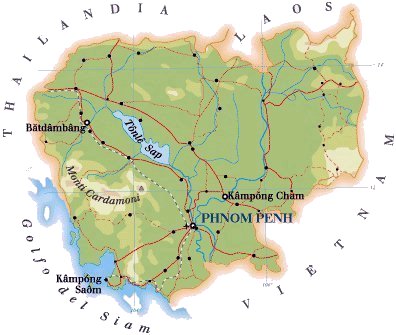
Area: 181,900 km ²
Population: 12,677,000 (estimated 2003)
Density: ab / Km ² 69
The form of government: Constitutional Monarchy
The Capital: Phnom Penh (980,000 inh.)
Other cities: Battambang 45,000 ab.
Ethnic groups: Khmer 93%, Vietnamese 4.5%, Chinese 2.5%
The countries bordering Thailand, Laos and Vietnam
The main mountains: Phnum Aôral 1775 m.
The main rivers: Mekong 515 Km (cambodian part, total
4544 Km)
The main lakes: Tonle Sap 1855 Km ²
The main islands: Kaoh Kong
Climate: Tropical monsoon
Language: Khmer (official), English and French
Religion: Theravada Buddhist 96%
The currency: Cambodian New Riel
|
|
|
|
|